
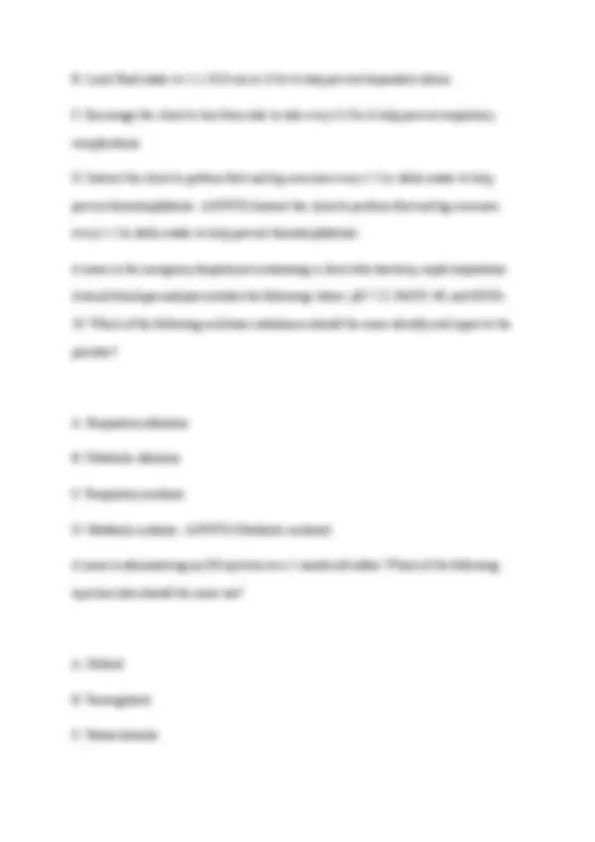
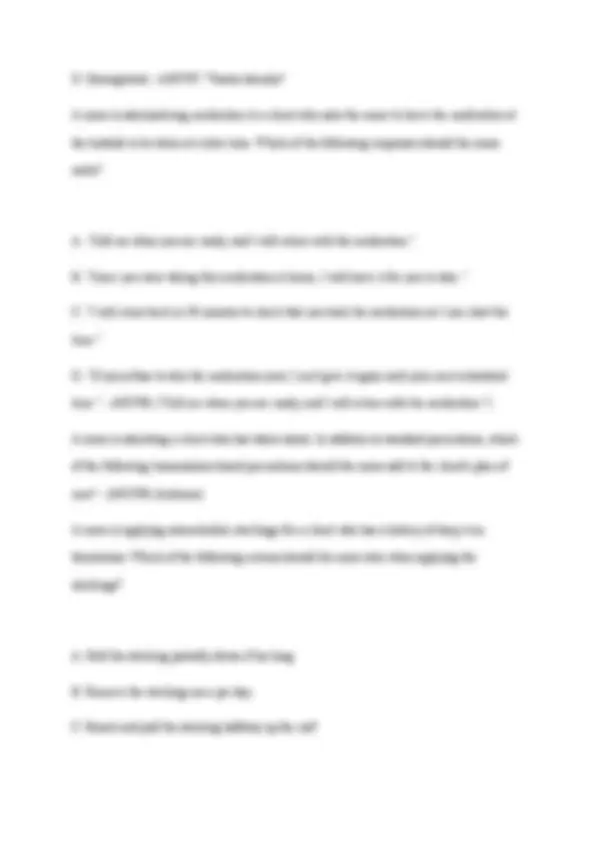
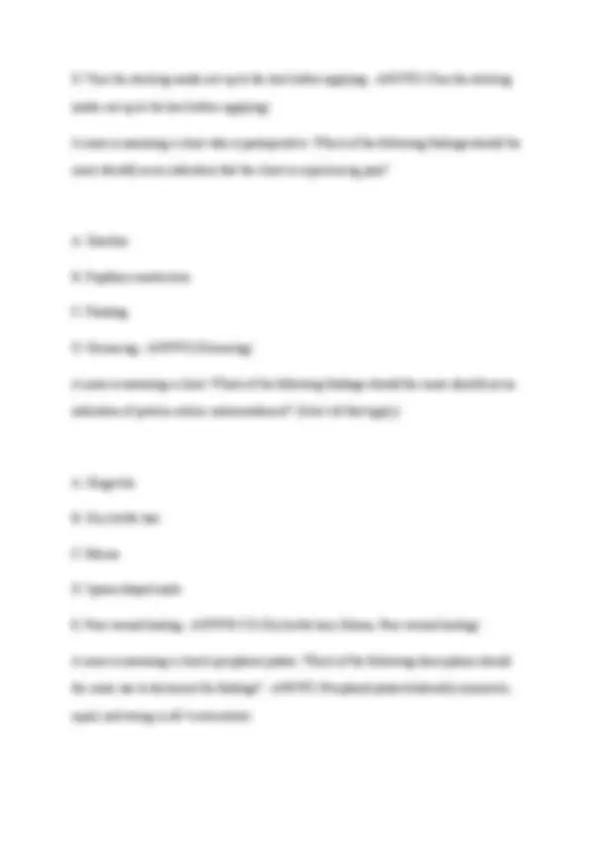
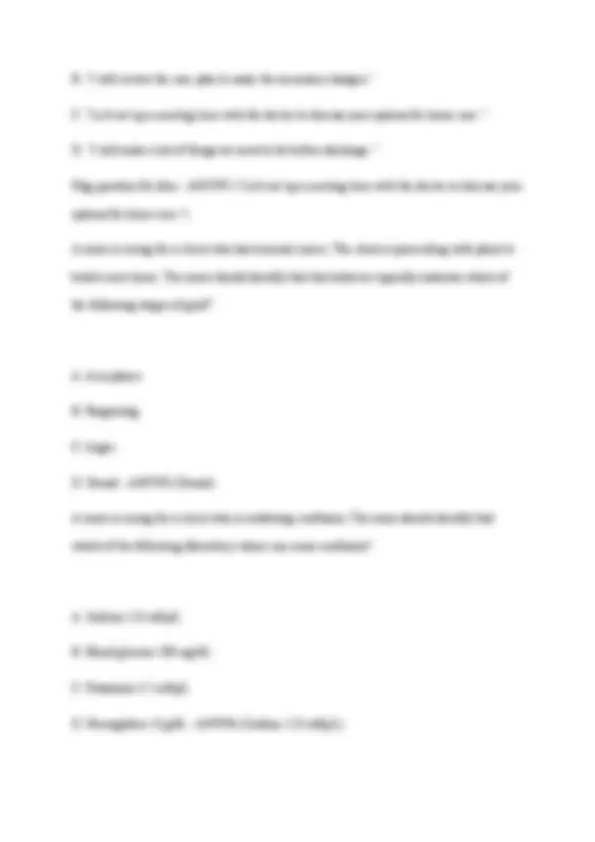
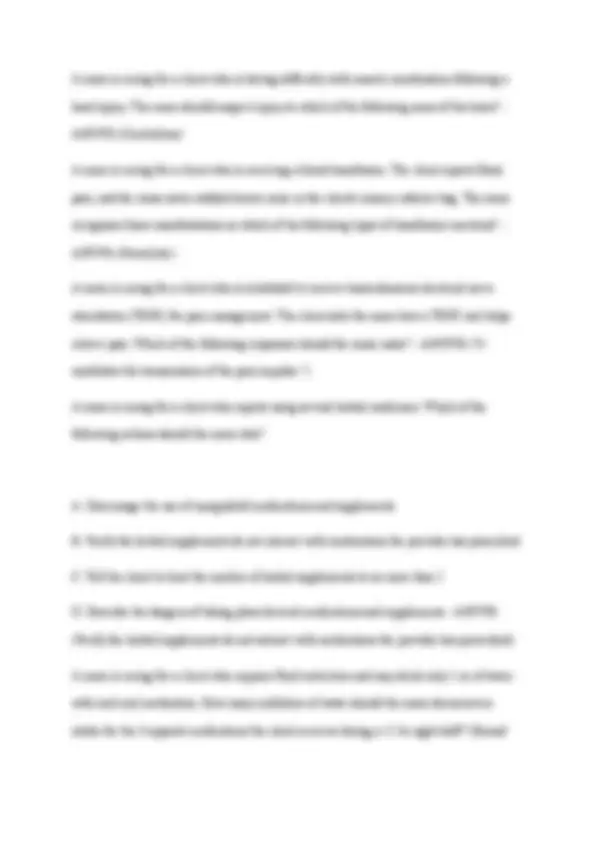
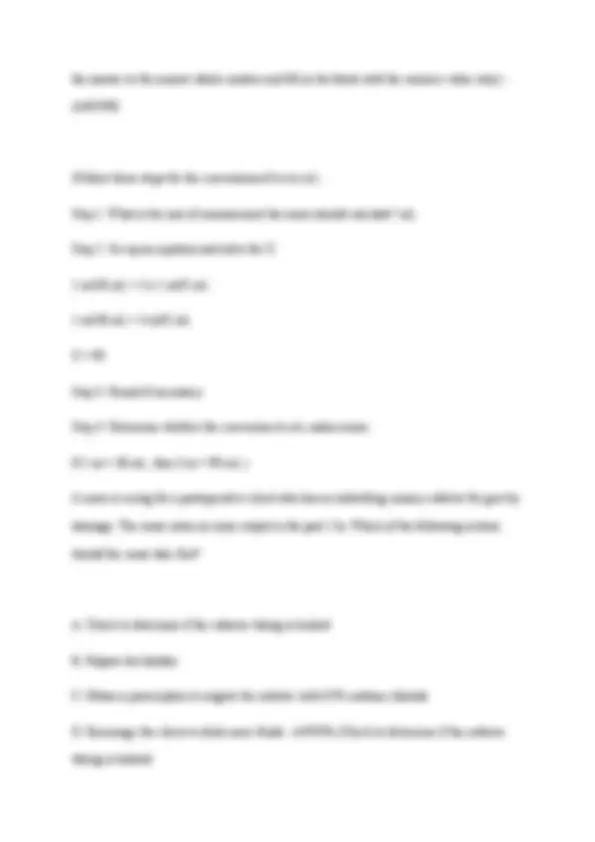
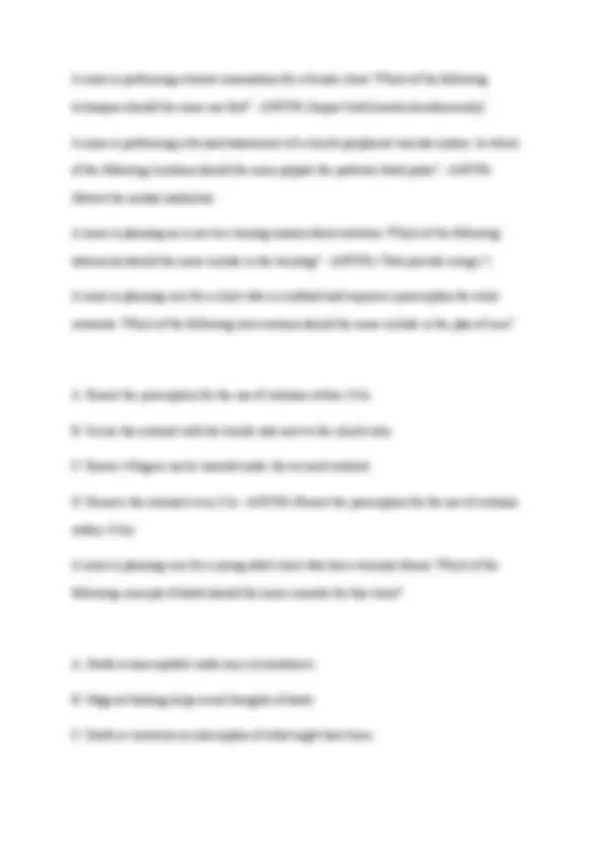
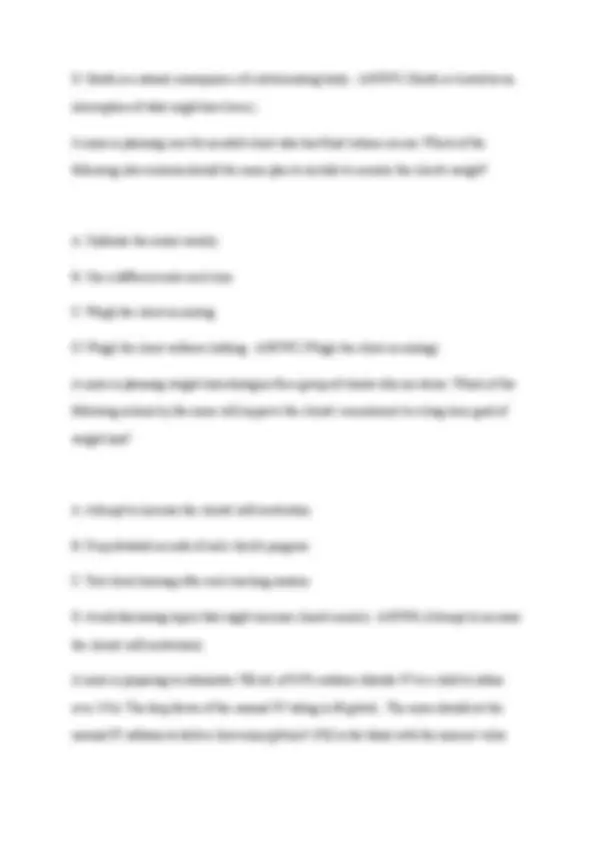
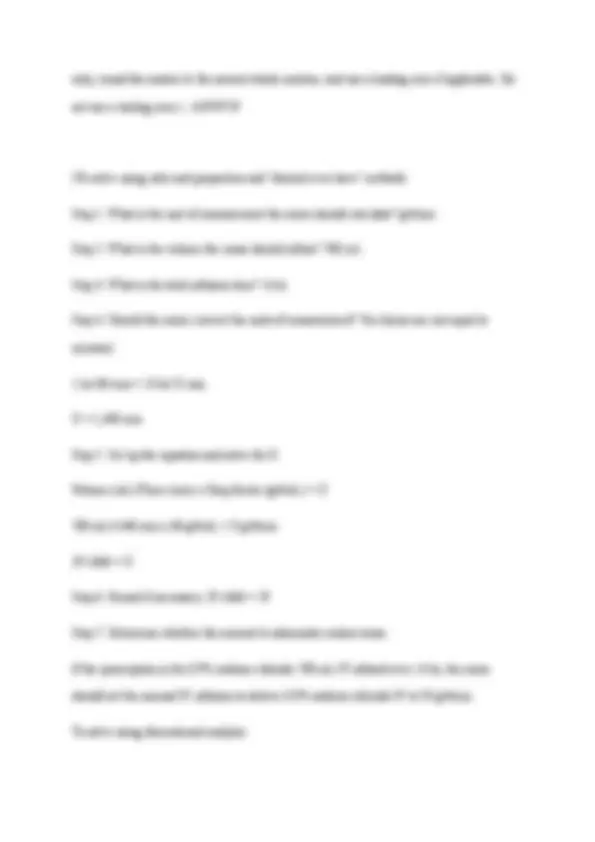
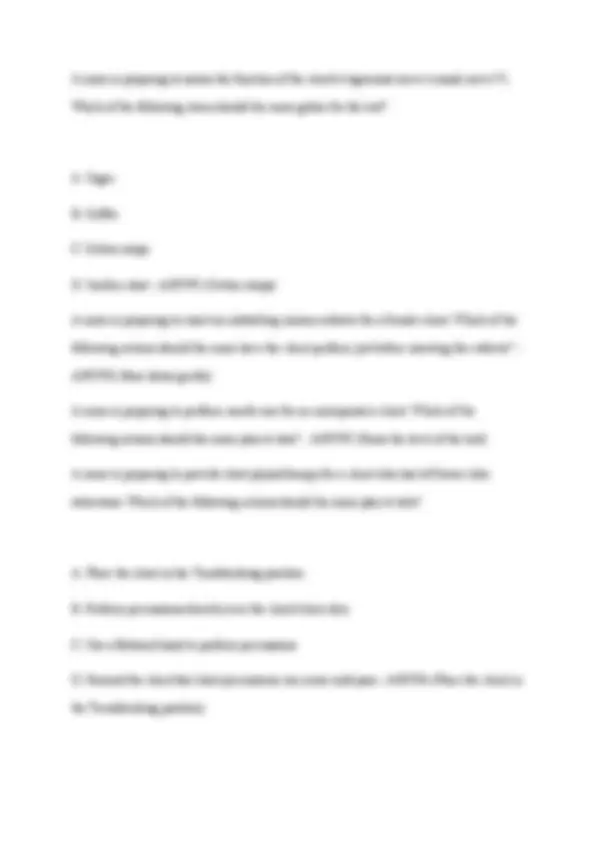
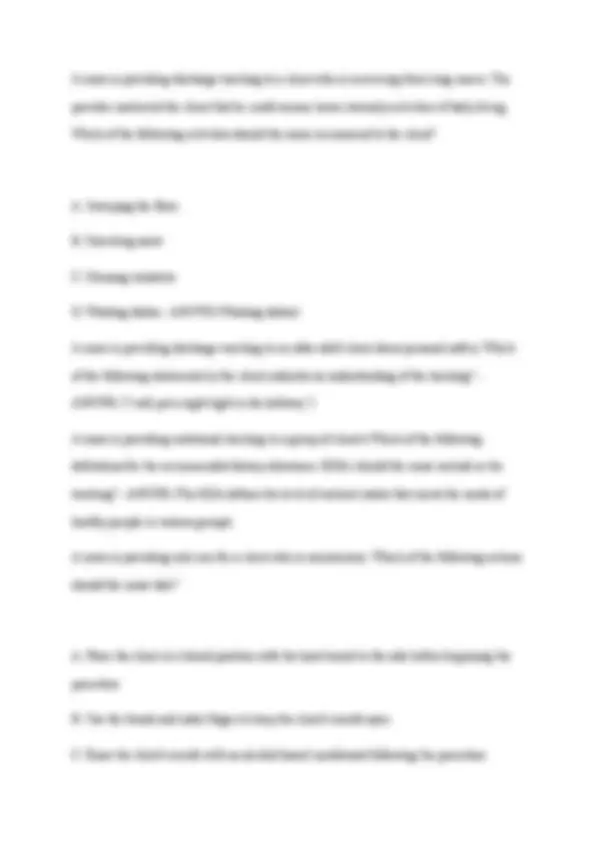
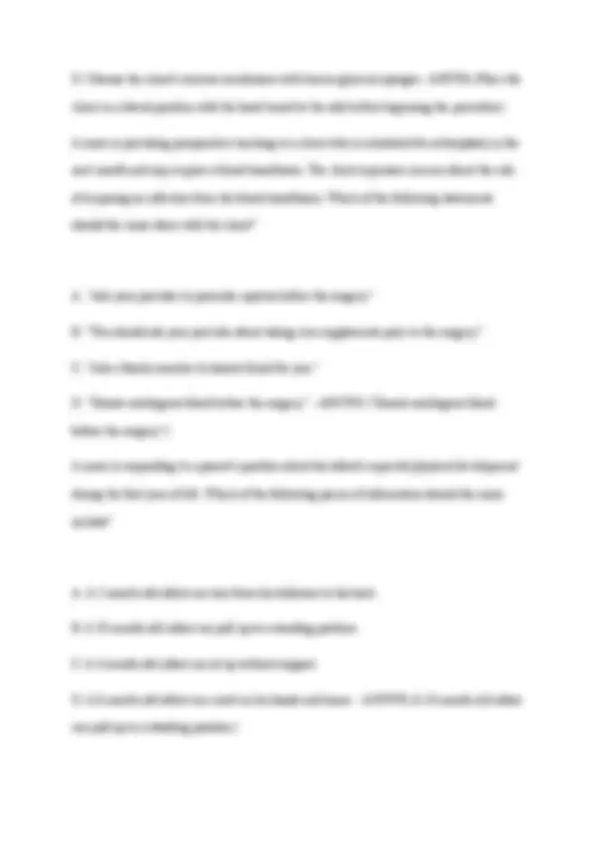
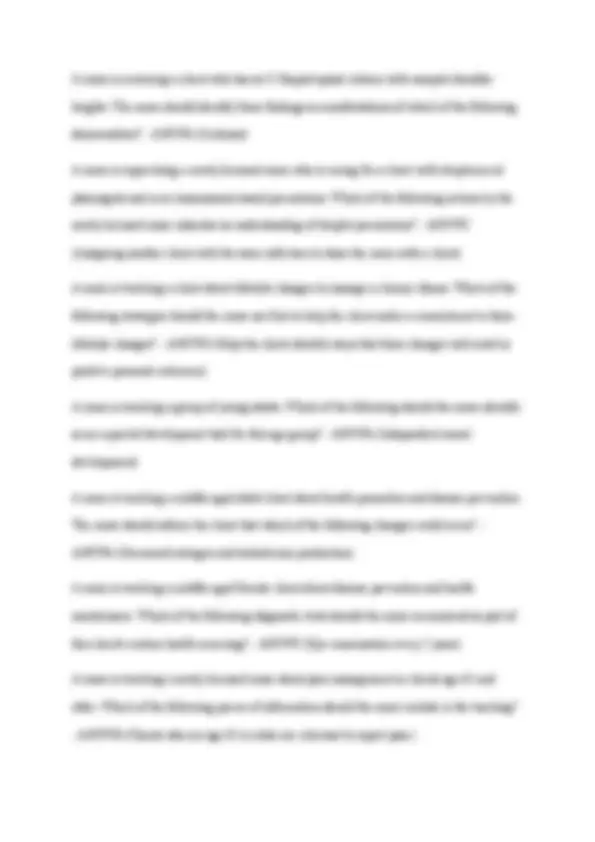
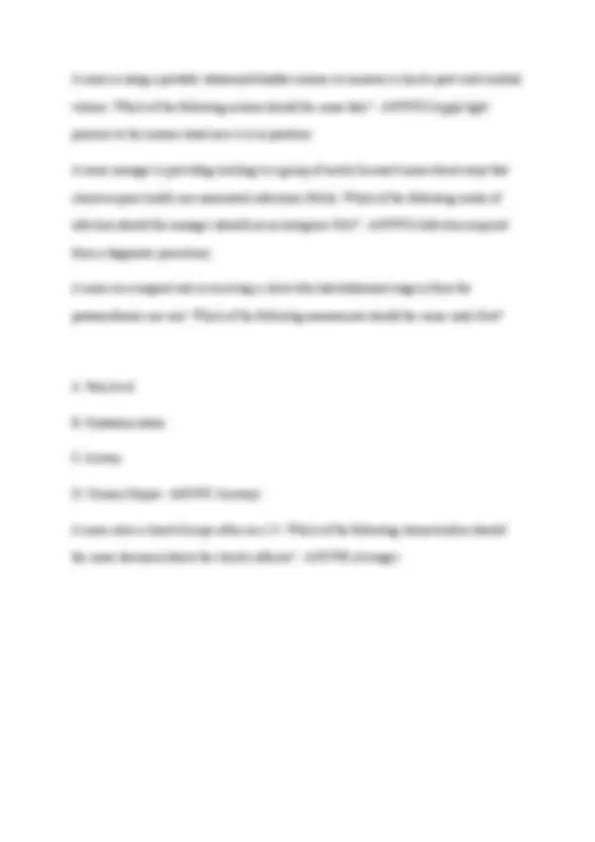


Study with the several resources on Docsity

Earn points by helping other students or get them with a premium plan


Prepare for your exams
Study with the several resources on Docsity

Earn points to download
Earn points by helping other students or get them with a premium plan
Community
Ask the community for help and clear up your study doubts
Discover the best universities in your country according to Docsity users
Free resources
Download our free guides on studying techniques, anxiety management strategies, and thesis advice from Docsity tutors
ATI Proctored Fundamentals Review Questions (Pt.1) and Correct Answers 2025
Typology: Exams
1 / 22

This page cannot be seen from the preview
Don't miss anything!















A middle aged adult client is discussing future plans with the nurse. Which of the following statements should the nurse identify as an indication that the client is having difficulty achieving Erikson's developmental task for the age group? - ANSWA (We miss our daughter so much that we are going to move closer to her.) A newly licensed nurse is preparing to administer medications to a client. The nurse notes that the provider has prescribed a medication that is unfamiliar to him. Which of the following actions should the nurse take? A. Consult the medication reference book available on the unit B. Ask a more experienced nurse for information about the medication C. Call the client's provider and verify the prescription D. Ask the client if she takes this medication at home - ANSWA (Consult the medication reference book available on the unit) A nurse documents the presence of clubbing of the fingernails for a client who has emphysema. Which of the following is the underlying cause of this finding? - ANSWD (Chronic hypoxemia) A nurse in an acute care facility is planning care for a client who is alert but temporarily immobile due to a total hip arthroplasty. Which of the following interventions should the nurse plan to take to prevent a complication of immobility? A. Move the client from supine to a low Fowler's position every 2-3 hr to help prevent orthostatic hypotension
D. Dorsogluteal - ANSWC "Vastus lateralis" A nurse is administering medication to a client who asks the nurse to leave the medication at the bedside to be taken at a later time. Which of the following responses should the nurse make? A. "Call me when you are ready, and I will return with the medication." B. "Since you were taking this medication at home, I will leave it for you to take." C. "I will come back in 30 minutes to check that you took the medication so I can chart the time." D. "If you refuse to take the medication now, I can't give it again until your next scheduled time." - ANSWA ("Call me when you are ready, and I will return with the medication.") A nurse is admitting a client who has tuberculosis. In addition to standard precautions, which of the following transmission-based precautions should the nurse add to the client's plan of care? - ANSWB (Airborne) A nurse is applying antiembolitic stockings for a client who has a history of deep vein thrombosis. Which of the following actions should the nurse take when applying the stockings? A. Roll the stocking partially down if too long B. Remove the stocking once per day C. Bunch and pull the stocking halfway up the calf
D. Turn the stocking inside out up to the heel before applying - ANSWD (Turn the stocking inside out up to the heel before applying) A nurse is assessing a client who is postoperative. Which of the following findings should the nurse identify as an indication that the client is experiencing pain? A. Diarrhea B. Pupillary constriction C. Flushing D. Grimacing - ANSWD (Grimacing) A nurse is assessing a client. Which of the following findings should the nurse identify as an indication of protein-calorie malnourishment? (Select all that apply.) A. Gingivitis B. Dry, brittle hair C. Edema D. Spoon-shaped nails E. Poor wound healing - ANSWB C E (Dry brittle hair, Edema, Poor wound healing) A nurse is assessing a client's peripheral pulses. Which of the following descriptions should the nurse use to document the findings? - ANSWC (Peripheral pulses bilaterally symmetric, equal, and strong in all 4 extremities)
D. Dried peas - ANSWA (Whole milk) A nurse is caring for a client who has a dysrhythmia. Which of the following techniques should the nurse to use to assess for a pulse deficit? - ANSWA (Obtain the apical and radial rates simultaneously) A nurse is caring for a client who has a history of dysrhythmias. Upon entering the room, the nurse discovers the client is unresponsive to verbal or painful stimuli, has no respirations, and is pulseless. Which of the following actions should the nurse take first? - ANSWA (Start chest compressions) A nurse is caring for a client who has a terminal illness. The client is restless and reports severe pain but refuses the prescribed opioid pain medication. Which of the following actions should the nurse take first? A. Ask why the client is refusing the pain medication B. Administer a PRN antianxiety medication C. Help the client change positions D. Offer the client a heat or cold pack to place on painful areas - ANSWA (Ask why the client is refusing the pain medication) A nurse is caring for a client who has a terminal illness. The family wants to care for the client at home. Which of the following statements indicates that the nurse understands family-centered care? A. "Social services can contact various community resources that will be helpful."
B. "I will review the care plan to make the necessary changes." C. "Let's set up a meeting time with the doctor to discuss your options for home care." D. "I will make a list of things we need to do before discharge." Flag question for later - ANSWC ("Let's set up a meeting time with the doctor to discuss your options for home care.") A nurse is caring for a client who has terminal cancer. The client is proceeding with plans to build a new home. The nurse should identify that this behavior typically indicates which of the following stages of grief? A. Acceptance B. Bargaining C. Anger D. Denial - ANSWD (Denial) A nurse is caring for a client who is exhibiting confusion. The nurse should identify that which of the following laboratory values can cause confusion? A. Sodium 123 mEq/L B. Blood glucose 100 mg/dL C. Potassium 3.5 mEq/L D. Hemoglobin 13 g/dL - ANSWA (Sodium 123 mEq/L)
the answer to the nearest whole number and fill in the blank with the numeric value only.) - ANSW (Follow these steps for the conversions of oz to mL: Step 1: What is the unit of measurement the nurse should calculate? mL Step 2: Set up an equation and solve for X. 1 oz/30 mL = 3 x 1 oz/X mL 1 oz/30 mL = 3 oz/X mL X = 90 Step 3: Round if necessary. Step 4: Determine whether the conversion to mL makes sense. If 1 oz = 30 mL, then 3 oz = 90 mL.) A nurse is caring for a postoperative client who has an indwelling urinary catheter for gravity drainage. The nurse notes no urine output in the past 2 hr. Which of the following actions should the nurse take first? A. Check to determine if the catheter tubing is kinked B. Palpate the bladder C. Obtain a prescription to irrigate the catheter with 0.9% sodium chloride D. Encourage the client to drink more fluids - ANSWA (Check to determine if the catheter tubing is kinked)
A nurse is caring for a semiconscious client who had a small-bore NG tube placed yesterday for the administration of enteral feeding. Which of the following methods should the nurse use to verify correct tube placement? (Select all that apply.) A. Auscultate injected air B. Verify the initial X-ray examination C. Measure the length of the exposed tube D. Determine the pH of aspirated fluid E. Check the aspirated fluid for glucose - ANSWB C D (Verify the initial X-ray examination, Measure the length of the exposed tube, Determine the pH of aspirated fluid) A nurse is caring for an adult client in the terminal stages of lung cancer who refuses any further treatment. The nurse should provide care that facilitates which of the following outcomes? - ANSWD (Supports self-determination) A nurse is changing the bed linens for a client who is on bed rest. Which of the following actions should the nurse perform? A. Place the soiled linens on the chair while making the bed B. Hold the linens away from the body and clothing C. Place the linens on the floor until a linen bag is available D. Shake the clean linens to unfold - ANSWB (Hold the linens away from the body and clothing)
A nurse is performing a breast examination for a female client. Which of the following techniques should the nurse use first? - ANSWA (Inspect both breasts simultaneously) A nurse is performing a focused assessment of a client's peripheral vascular system. In which of the following locations should the nurse palpate the posterior tibial pulse? - ANSWA (Below the medial malleolus) A nurse is planning an in-service training session about nutrition. Which of the following statements should the nurse include in the teaching? - ANSWA ("Fats provide energy.") A nurse is planning care for a client who is confused and requires a prescription for wrist restraints. Which of the following interventions should the nurse include in the plan of care? A. Renew the prescription for the use of restrains within 24 hr B. Secure the restraint with the buckle side next to the client's skin C. Ensure 4 fingers can be inserted under the secured restraint D. Remove the restraint every 3 hr - ANSWA (Renew the prescription for the use of restrains within 24 hr) A nurse is planning care for a young adult client who has a terminal illness. Which of the following concepts of death should the nurse consider for this client? A. Death is unacceptable under any circumstances. B. Magical thinking helps avoid thoughts of death. C. Death is viewed as an interruption of what might have been.
D. Death is a natural consequence of a deteriorating body. - ANSWC (Death is viewed as an interruption of what might have been.) A nurse is planning care for an adult client who has fluid volume excess. Which of the following interventions should the nurse plan to include to monitor the client's weight? A. Calibrate the scales weekly B. Use a different scale each time C. Weigh the client on arising D. Weigh the client without clothing - ANSWC (Weigh the client on arising) A nurse is planning weight-loss strategies for a group of clients who are obese. Which of the following actions by the nurse will improve the clients' commitment to a long-term goal of weight loss? A. Attempt to increase the clients' self-motivation B. Keep detailed records of each client's progress C. Test client learning after each teaching session D. Avoid discussing topics that might increase clients' anxiety - ANSWA (Attempt to increase the clients' self-motivation) A nurse is preparing to administer 700 mL of 0.9% sodium chloride IV to a child to infuse over 24 hr. The drop factor of the manual IV tubing is 60 gtt/mL. The nurse should set the manual IV infusion to deliver how many gtt/min? (Fill in the blank with the numeric value
Step 1: What is the unit of measurement the nurse should calculate? gtt/min Step 2: What is the quantity of the drop factor that is available? 60 gtt/min Step 3: What is the total infusion time? 24 hr Step 4: What is the volume the nurse should infuse? 700 mL Step 5: Should the nurse convert the units of measurement? Yes (hours are not equal to minutes) 1 hr/60 min = 24 hr/X min Step 6: Set up the equation and solve for X. X = Quantity/1 mL x Conversion (hr)/Conversion (min) x Volume (mL)/Time (hr) X gtt/min = 60 gtt/1 mL x 1 hr/60 min x 70 mL/24 hr X = 29. Step 7: Round if necessary. 29.1666 = 29 Step 8: Determine whether the amount to administer makes sense.) A nurse is preparing to administer a cleansing enema to a client. Which of the following actions should the nurse plan to take? A. Insert the rectal tube 15.2 cm (6 in) B. Wear sterile gloves to insert the tubing C. Position the client on his left side
D. Hold the solution bag 91 cm (36 in) above the client's rectum - ANSWC (Position the client on his left side) A nurse is preparing to administer a medication to a client. Which of the following administration schedules should the nurse identify as a prescription to administer the medication once and as soon as possible? A. Stat prescription B. PRN prescription C. Standing prescription D. Single prescription - ANSWA "Stat prescription" A nurse is preparing to administer an afternoon dose of ampicillin to a client. The client appears upset and refuses to take the medication before throwing the pill on the floor. Which of the following entries should the nurse enter into the client's medical record? - ANSWD (The client threw the medication on the floor.) A nurse is preparing to administer an intramuscular injection to a young adult client. Which of the following injection sites is the safest for this client? A. Vastus lateralis B. Dorsogluteal C. Deltoid D. Ventrogluteal - ANSWD (Ventrogluteal)
A nurse is providing discharge teaching to a client who is recovering from lung cancer. The provider instructed the client that he could resume lower-intensity activities of daily living. Which of the following activities should the nurse recommend to the client? A. Sweeping the floor B. Shoveling snow C. Cleaning windows D. Washing dishes - ANSWD (Washing dishes) A nurse is providing discharge teaching to an older adult client about personal safety. Which of the following statements by the client indicates an understanding of the teaching? - ANSWB ("I will put a night-light in the hallway.") A nurse is providing nutritional teaching to a group of client's Which of the following definitions for the recommended dietary allowance (RDA) should the nurse include in the teaching? - ANSWB (The RDA defines the level of nutrient intake that meets the needs of healthy people in various groups) A nurse is providing oral care for a client who is unconscious. Which of the following actions should the nurse take? A. Place the client in a lateral position with the head turned to the side before beginning the procedure B. Use the thumb and index finger to keep the client's mouth open C. Rinse the client's mouth with an alcohol-based mouthwash following the procedure
D. Cleanse the client's mucous membranes with lemon-glycerin sponges - ANSWA (Place the client in a lateral position with the head turned to the side before beginning the procedure) A nurse is providing preoperative teaching to a client who is scheduled for arthroplasty in the next month and may require a blood transfusion. The client expresses concern about the risk of acquiring an infection from the blood transfusion. Which of the following statements should the nurse share with the client? A. "Ask your provider to prescribe epoetin before the surgery." B. "You should ask your provider about taking iron supplements prior to the surgery." C. "Ask a family member to donate blood for you." D. "Donate autologous blood before the surgery." - ANSWD ("Donate autologous blood before the surgery.") A nurse is responding to a parent's question about his infant's expected physical development during the first year of life. Which of the following pieces of information should the nurse include? A. A 2-month-old infant can turn from his abdomen to his back. B. A 10-month-old infant can pull up to a standing position. C. A 4-month-old infant can sit up without support. D. A 6-month-old infant can crawl on his hands and knees. - ANSWB (A 10-month-old infant can pull up to a standing position.)